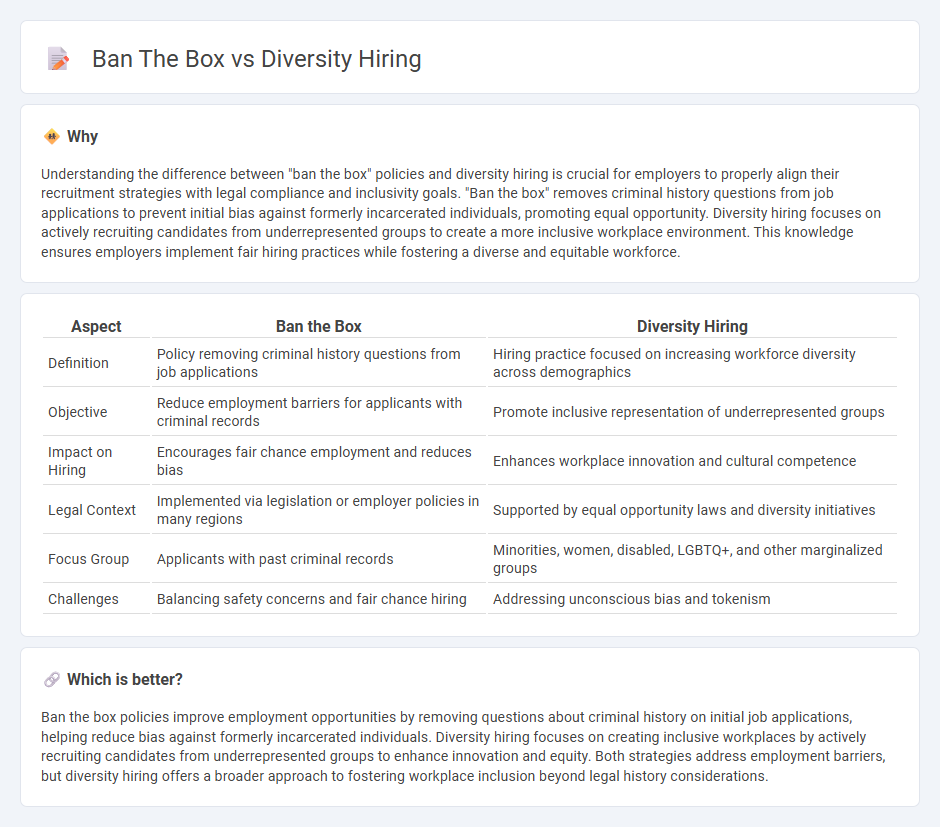
Ban the Box policies remove criminal history questions from initial job applications, promoting fair hiring practices and reducing barriers for formerly incarcerated individuals. Diversity hiring focuses on creating inclusive work environments by actively recruiting candidates from underrepresented groups to enhance innovation and organizational performance. Explore how these strategies intersect to foster equitable employment opportunities.
Why it is important
Understanding the difference between "ban the box" policies and diversity hiring is crucial for employers to properly align their recruitment strategies with legal compliance and inclusivity goals. "Ban the box" removes criminal history questions from job applications to prevent initial bias against formerly incarcerated individuals, promoting equal opportunity. Diversity hiring focuses on actively recruiting candidates from underrepresented groups to create a more inclusive workplace environment. This knowledge ensures employers implement fair hiring practices while fostering a diverse and equitable workforce.
Comparison Table
| Aspect | Ban the Box | Diversity Hiring |
|---|---|---|
| Definition | Policy removing criminal history questions from job applications | Hiring practice focused on increasing workforce diversity across demographics |
| Objective | Reduce employment barriers for applicants with criminal records | Promote inclusive representation of underrepresented groups |
| Impact on Hiring | Encourages fair chance employment and reduces bias | Enhances workplace innovation and cultural competence |
| Legal Context | Implemented via legislation or employer policies in many regions | Supported by equal opportunity laws and diversity initiatives |
| Focus Group | Applicants with past criminal records | Minorities, women, disabled, LGBTQ+, and other marginalized groups |
| Challenges | Balancing safety concerns and fair chance hiring | Addressing unconscious bias and tokenism |
Which is better?
Ban the box policies improve employment opportunities by removing questions about criminal history on initial job applications, helping reduce bias against formerly incarcerated individuals. Diversity hiring focuses on creating inclusive workplaces by actively recruiting candidates from underrepresented groups to enhance innovation and equity. Both strategies address employment barriers, but diversity hiring offers a broader approach to fostering workplace inclusion beyond legal history considerations.
Connection
Ban the Box policies improve employment opportunities by removing criminal history questions from initial job applications, fostering a more inclusive hiring process. Diversity hiring initiatives seek to increase representation of underrepresented groups, aligning with Ban the Box goals by reducing barriers that disproportionately impact marginalized communities. Together, these strategies promote equitable employment practices and enhance workforce diversity.
Key Terms
Equal Opportunity
Diversity hiring initiatives emphasize creating inclusive work environments by actively recruiting candidates from varied backgrounds to promote equal opportunity. Ban the Box policies remove criminal history questions from initial job applications, reducing bias against applicants with past convictions and enhancing fair access to employment. Explore how these strategies complement each other to strengthen workplace equality and compliance.
Criminal History Disclosure
Diversity hiring initiatives aim to create inclusive workplaces by broadening candidate pools to include underrepresented groups, while Ban the Box policies specifically address the removal of criminal history questions from job applications to reduce employment barriers for individuals with criminal records. Ban the Box facilitates fairer recruitment processes by delaying disclosure of criminal history until later stages, promoting second-chance employment opportunities. Explore in-depth strategies and impacts of both approaches to understand how organizations can enhance equitable hiring practices.
Inclusive Recruitment
Diversity hiring focuses on proactively seeking candidates from varied backgrounds to create equitable workplaces, while Ban the Box removes criminal history questions from initial job applications to reduce bias against formerly incarcerated individuals. Inclusive recruitment integrates these strategies by fostering transparency, fairness, and broad access to employment opportunities, ultimately enhancing organizational culture and innovation. Explore more to understand how combining diversity hiring and Ban the Box policies drives inclusive workforce growth.
Source and External Links
11 Diversity Recruiting Strategies to Upgrade Inclusive Hiring - Diversity hiring best practices include creating inclusive job descriptions, using blind recruitment, forming diverse hiring teams, unconscious bias training, and tracking diversity metrics for accountability and progress.
Diversity hiring 101: A quintessential guide for recruiters - Effective diversity hiring involves conducting a diversity employment review, setting focused goals, and revising candidate sourcing strategies, such as writing job descriptions in inclusive language to attract diverse applicants.
Benefits of Diversity Hiring & How to Do It - Revelo - Diversity hiring brings broader candidate pools, unique perspectives, improved innovation, and reduced unconscious bias through methods like blind resumes and standardized interviews, fostering fairness and better cultural matches.
 dowidth.com
dowidth.com